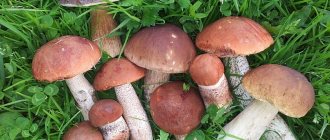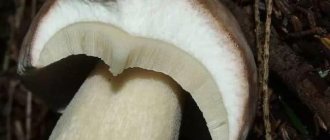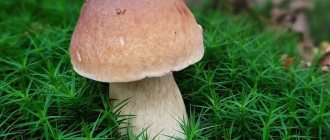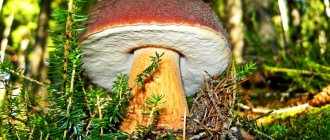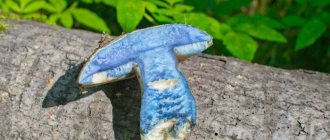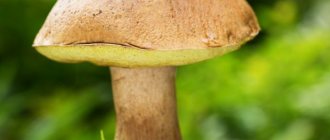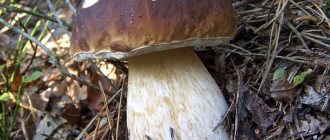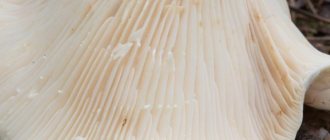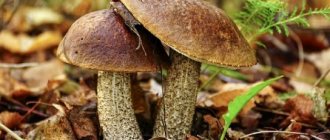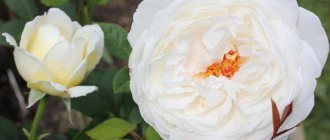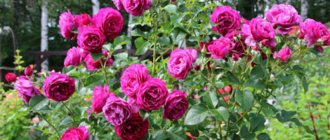General information about porcini mushroom
The porcini mushroom is an edible mushroom from the genus Boletaceae, family Boletaceae, class Agaricomycetes.
— Advertising —
It is not known exactly when the name of the species “ceps” appeared. In ancient times, it was customary to call all edible mushrooms “mushrooms,” but it was in relation to the porcini mushroom that this word was also fixed in the name, since it was considered one of the most valuable species. And the adjective “white” mushroom received as the opposite of the less valuable “black” tubular mushroom (obabok), since its flesh does not change when cut and does not darken during drying.
Favorite places for mushrooms to grow
Mushroom pickers have favorite places for collecting boletus mushrooms, which are convenient in their location and rich in harvest.
One of these places is the Buzuluksky pine forest, located on the border of the Orenburg and Samara regions. It is located 15 km from the city of Buzuluk, after which it is named. The area of the forest is 1067.88 km2.
The main attraction of the area is the oldest pine trees, ranging from 300 to 350 years old. Bor borders the steppe and is bordered by deciduous forest belt. A large variety of mushrooms grow here: boletus, honey mushrooms, saffron milk caps, boletus and russula.
While in these latitudes, you can also visit the villages of Mekhzavod, Upravlencheskiy and the villages of Shiryaevo, Borskoye and Malaya Malyshevka. They contain oyster mushrooms, morels, champignons and other mushrooms.
A good place for gathering is the Ulyanovsk forest park in the Novomoskovsk administrative district. It is located in a zone of spruce-deciduous forests without swamps. The predominant trees are birch, pine, oak and spruce. Their age ranges from 50 to 100 years.
The most common mushrooms in the forest park are: champignons, boletus mushrooms, boletus mushrooms and entolomas. If you're lucky, you might find a family of boletus.
An excellent solution would be to visit the Chelyabinsk city forest, located on the southwestern outskirts of the city. Borovaya territory occupies 1200 hectares. The forest is mainly filled with pine species with an admixture of warty and downy birch, aspen and alder.
There are also several productive areas near the city of Chelyabinsk: the areas of the villages of Shakhmatovo, Birgilda, Taktybai, the Ilmensky Nature Reserve and forests on the border with Bashkiria. The boron region of these places is full of russula, boletus, boletus, boletus and boletus. Some areas of these territories are covered with entire families of these fungi.
Characteristics of porcini mushroom
hat
The diameter of the cap of a mature porcini mushroom is from 7 to 30 cm (sometimes reaching 50 cm). It is bare, convex in shape, slightly flattened in old mushrooms, with a smooth or wrinkled surface, thin felt at the edge. During dry weather, the cap of the porcini mushroom becomes matte, becomes covered with cracks, and in humid weather it becomes slimy. The color of the cap varies from red-brown to white, darkening with age. Lemon-yellow, orange, purple colors occur. The edges of the cap are light, with a white or yellowish border. The skin does not separate from the pulp.
Pulp
— Advertising —
The pulp of a young porcini mushroom is white, strong, juicy and fleshy. With age, it becomes fibrous and turns yellow. The color does not change when cut. Under the dark skin there is usually a brown or red-brown layer. The taste is mild, weakly expressed. The raw pulp also has a faint smell, but a characteristic pleasant mushroom aroma appears when dried or cooked.
Leg
The leg is massive, from 8 to 25 cm in height (about 12 on average) and 7 cm in diameter (sometimes up to 10 cm or more). It is barrel-shaped or club-shaped in shape, gradually becoming cylindrical with a thickened base. The color of the leg is whitish, brownish, sometimes reddish. A network of light veins is noticeable on it.
The tubular layer consists of small, rounded tubes from 1 to 4 cm in length. It is light, easily separated from the pulp, and turns yellow or green with age. There are no remains of the bedspread.
Picking mushrooms - how to do it right?
When going to the forest, you need to understand where, when and how to collect porcini mushrooms. It is preferable to start “hunting” for them in July and August. They especially scatter across the soil after brief thunderstorms and warm fogs at night. In summer, the boletus mushroom grows for 6-9 days, in autumn – 9-15.
It is advisable to come to the forest before the sun has risen, when the white mushroom is clearly visible. Move slowly, carefully examining the ground. Especially places with sand and loam, where the soil does not flood. When the summer is damp, it is worth looking at a distance from trees, on hills and in places well lit by the sun. If the season is dry, whites hide near the trees, where the grass is thicker. They love to live next to morels.
The best specimens for collecting are those with a cap diameter of approximately 4 cm. Boletus is loved by various kinds of pests, so you need to look out for them carefully, especially in the cap. Be sure to cut it into pieces and remove the wormholes. Within 10 hours, the porcini mushroom must be processed (placed for drying, salting, fried, etc.), otherwise most of the beneficial properties will be lost.
Where do porcini mushrooms grow?
— Advertising —
The porcini mushroom is found on all continents except Australia. Its natural distribution areas are almost the entire territory of Europe from Scandinavia to Italy, North America, and North Africa. In Asia, the white mushroom is common in Turkey, Transcaucasia, Mongolia, China, Japan, Siberia and the Far East. With seedlings of coniferous trees, the white mushroom was introduced to South America, New Zealand and South Africa.
The porcini mushroom grows next to deciduous and coniferous trees; it especially often chooses spruce, pine, oak and birch. Grows in forests with moss or lichen cover, where trees are 50 years old or older, on well-drained but not too wet soils, for example, sandy and loamy.
There is a relationship between the appearance of the porcini mushroom and other species: in the fall in the forests it chooses the greenfinch as its neighbor, in the oak thickets it chooses the russula, and in birch forests it grows next to the chanterelle.
The porcini mushroom has penetrated far into the Arctic zone and is found in the tundra, forest-tundra and taiga. The abundance of its growth decreases from west to east in Eurasia. In the forest-steppe there is much less of it, and the porcini mushroom completely disappears in the steppe zone. It is less common in mountain forests than in lowland forests. Rarely found on peat bogs or swamps.
When does it grow?
Size, color, structural features - all this depends on the place where the porcini mushroom grows. The period of active growth begins in late spring - early summer. In October-November, mushroom shoots appear in large quantities. Porcini mushrooms take quite a long time to ripen. They grow in whole families or ring colonies. That is why, seeing a whole “family” of boletus mushrooms, the mushroom picker will definitely be in a better mood.
Representatives of the Boletaceae family can grow in deciduous, coniferous, and mixed forests. They concentrate under pines, birches, spruces, oaks, fir, and hornbeams. It is recommended to collect mushrooms in places where moss and lichen grow, as well as on loamy, sandy, sandy loam soils. Boletuses almost never grow in swamps and peat areas. Mushrooms love light and do not like waterlogged soil and low air temperatures.
The white mushroom was also seen in the forest-tundra and forest-steppe, but in the steppe zones it is impossible to find the white mushroom.
When do porcini mushrooms appear?
In northern temperate climates, the season for porcini mushroom begins in mid-June and lasts until the end of September, with mass collection occurring at the end of August. The white mushroom appears briefly at the end of May, and in warm areas it bears fruit even in October.
The optimal temperature for fruiting in July and August is from 15 to 18 °C, in September from 8 to 10 °C. Fruiting bodies develop poorly with large temperature changes between day and night and heavy rainfall. The massive appearance of the porcini mushroom is facilitated by short thunderstorms and warm, foggy nights. The porcini mushroom is a light-loving species, but is sometimes found in shaded places.
Distribution and collection season
They grow next to many trees, but most of all they love the “community” of pine forests, birch or oak groves, and spruce forests.
In the fall, the boron form friendly shares space with the green russula in the oak forest and with the chanterelle next to the birches, appearing at the same time as the greenfinch.
There is a high probability of finding such whites in pine trees that are 20-25 years old, or pine forests that are at least 50 years old and covered with moss and lichen.
The best temperature for mushroom growth is 15-18 degrees Celsius in the summer months, and 8-10 in September. Serious temperature changes and rain inhibit the development of mycelium. White hare grows best after minor thunderstorms and foggy, warm nights.
They like soils with the presence of sand and loam, without excess water. Peat bogs and swampy areas are excluded. They also do not like hot places, although they prefer good lighting.
You can meet the hare on all continents except Australia. It grows especially actively in Europe, northern America and even Africa. In Asia it reaches Japan and China. In Russian forests - almost everywhere, reaching the tundra and Chukotka, but is not found in the steppes. Doesn’t like to “climb mountains” too much.
Fruiting occurs solitary, closer to autumn days - in clusters.
Porcini mushrooms grow in seasons: in more temperate climatic latitudes - from mid-June to the end of September, the most mushroom time is from the fifteenth of August. Where it is warmer, it may appear by the end of May and not disappear until October.
Time and place for collecting porcini mushrooms in Russia
In the northern regions of Russia, porcini mushrooms begin to bear fruit from the beginning of summer, in the southern regions - from mid-May. Fruiting dates may vary depending on temperature conditions.
Mass harvesting begins in the middle of the last month of summer. It is at this time that mushroom pickers go on a quiet hunt and return with full baskets. In Siberian forests, mushrooms grow in the taiga, in other districts in forests with a predominance of coniferous or mixed species . Experienced mushroom pickers advise looking for mushrooms around deciduous trees over 50 years old and pine trees 20 to 30 years old. The soil should be sandy, sandy loam and loamy. Mushroom pickers have nothing to do in swampy areas, since mushrooms practically do not grow there.
Where and when to look for porcini mushrooms in Belarus
Mushrooms are a traditional and favorite delicacy of Belarusian cuisine. The republic has ideal mushroom conditions: the presence of mixed forests and swamps. Unique climatic conditions have a beneficial effect on the growth of various types of mushrooms. The first edible mushrooms begin to appear in the first month of spring, but the specific timing depends on weather conditions. The Minsk and Vitebsk regions are considered the best mushroom grounds. A large harvest can be harvested in forest areas located in the Vitebsk direction.
It is recommended to look for porcini mushrooms among coniferous trees. He prefers to settle in clearings and forest edges. On hot summer days, it most often hides in shelters under trees, and in cool autumn it basks in open sunny areas, especially on moist soil.
In order not to miss a hidden fungus, it is important to carefully examine the places along the paths. Experienced mushroom pickers advise not to pass by small, half-dried forest streams and hillocks. It is especially difficult to find it in fallen leaves.
After haymaking (usually from the second half of July), a second layer of mushrooms appears. After 2 - 3 weeks there is a lull. Then comes the most abundant mushroom layer, which continues until frost. During the summer, the mycelium grew, and the soil warmed up, which contributes to abundant fruiting.
Season and places for collecting porcini mushrooms in Ukraine
Not many Ukrainian residents show interest in early mushrooms. The massive harvest of valuable harvest begins at the end of the spring period. In addition to warm weather, another necessary condition for the appearance of mushrooms is the presence of a moist top layer of soil, otherwise if there is a lack of moisture, there will be no harvest.
You can go looking for porcini mushrooms at any time throughout the summer. There are especially many of them growing in the forests of western Ukraine. These areas are characterized by the presence of tall trees, which helps maintain the required level of moisture, stimulating the growth of fungi.
Autumn is also a favorable period for collecting forest gifts, since this time is characterized by heavy rainfall. Experienced mushroom pickers note the high productivity of the Tsyuryupinsky region, where, in addition to white mushrooms, other equally tasty mushrooms grow, for example, boletus and truffles.
Porcini mushrooms are found before the temperature drops in October, although in the Carpathians they can be collected all year round. The product is known for its nutritional and healing properties. Despite the fact that pests are often observed inside the fruiting body, they do not lose their value.
Collection of porcini mushrooms in Germany
There are at least five thousand known species of mushrooms in Germany. The third part is edible. Porcini mushrooms, actively used in German cuisine, can be harvested as early as May. They appear in rare young oak plantings, clearings and row-spacings. A little later, umbrella mushrooms and chanterelles begin to appear. The peak is in autumn. In the regions located on the southern side of Lake Constance, even black truffles, which are classified as gourmet foods, are found.
Before going in search of a harvest, in Germany they offer to complete preparatory courses, including theoretical studies and practice. In order not to confuse useful forest beauties with poisonous individuals, it is advised to download a special application to your electronic device, which describes each type of mushroom in detail and in pictures.
But even experienced mushroom pickers cannot collect as many mushrooms as they want, since limited collection is allowed by law. If you abuse natural gifts, you can receive a large fine.
Edibility of porcini mushroom
The ancient Romans already consumed porcini mushrooms. And now in Italy it is highly valued. In Eastern Europe it was even called the “king of mushrooms.”
It is recommended to use porcini mushroom fresh, boiled, fried, dried or pickled. During drying, these mushrooms acquire a pleasant smell and do not darken. Dried ground porcini mushroom powder is used to season various dishes. They also eat the porcini mushroom raw, in salads with butter, spices, lemon juice and cheese. Porcini mushroom sauce is served with rice and meat dishes.
Interesting Facts
- Boletus contains substances that have antitumor properties.
- When eating dried porcini mushrooms, up to 80% of the protein is absorbed.
- The record-breaking mushroom weighing almost 7 kg was discovered in 1964 in the Vladimir region.
- The latest appearance of boletus was recorded on December 29, 1974 in the Zhitomir region.
- In Italy, free mushroom picking is limited, so “mushroom tours” to Finland are organized.
Types of porcini mushroom
Spruce porcini mushroom (Boletus edulis f. Edulis)
The most common subspecies has a long stem with a thickening at the bottom. The cap is brown with a reddish or chestnut tint, smooth, dry. Grows in spruce and fir forests, everywhere except Iceland. Fruiting occurs from June to October.
White oak mushroom (Boletus edulis f. Quercicola)
The cap is gray-brown with light spots. The pulp is loose. Distributed in oak forests from June to October, in Russia, the Caucasus, and Primorsky Territory.
White birch mushroom (Boletus betulicolus)
The cap is light, almost white, the species grows under birch trees.
White pine mushroom (Boletus pinophilus)
A boron form with a large dark cap, sometimes with a purple tint. The pulp under the skin is brownish-red.
Dark bronze white mushroom, or hornbeam (Boletus aereus)
A dark, almost black mushroom that is found in the beech and oak forests of Europe, in its western and southern regions (from Spain to Western Ukraine), as well as in the USA.
White mushroom (Boletus reticulatus)
The cap is brownish or buffy, the stem is short, cylindrical, similar to a moss fly. Grows in beech and hornbeam forests of Europe, Transcaucasia, North America and North Africa. Fruits in June – September.
Where is the resident and where is the guest?
Boletus, porcini mushroom - all mushrooms grow under spruce-pine trees, as well as under birch and oak trees, most often from June to the end of August. Selects older trees. In young growths there is always an abundance of butterflies and moss mushrooms, but not white ones. Prefers to have red fly agarics as neighbors. It does not grow next to boletus mushrooms, its competitors.
Moderately damp clearings are its habitat, although it sometimes settles under dense crowns in forests. It is considered a light-loving species, but hides from the bright sun. Avoids thickets of ferns. Mushroom pickers say: putting boletus in a basket is prose, picking porcini mushrooms is forest poetry. Sly creatures often hide in short grass, under fir trees, masquerading as leaves, moss, and fallen pine needles. For them, the “whites,” the forest dictates what “clothes” to wear - change the color of the hat from whitish (in birch forests), brownish-olive (in pine forests) to brown with a gray tint (in oak forests) and reddish (in spruce forests).
The king of mushrooms rarely grows alone, more often in families; it is not without reason that experienced mushroom pickers say: “If you find one, look for another nearby.” The heart is pounding, and the eyes are vigilantly searching everything around: is there such a strong guy in the neighborhood? Don't miss it! You can find at least two, and if you're lucky, a whole family of up to 40 porcini mushrooms, because the mycelium - a kind of root system - can extend over a distance of up to 500 m or more.
Inedible types of porcini mushroom
A similar species to the porcini mushroom is the gall mushroom - a tubular mushroom from the genus Tilopilus of the Boletaceae family. The gall mushroom is inedible due to its bitter pulp. During cooking, the bitterness of this mushroom only intensifies. It is distinguished by a tubular layer that turns pink with age, and the surface of its stem is covered with a rough, dark-colored mesh.
Similar species
Like most edible mushrooms, white mushrooms have several very dangerous “relatives” that can mislead an inexperienced mushroom picker.
Gall mushroom (bitter mushroom)
The insidious “imposter” is similar in appearance not only to boletus, but also to boletus.
To distinguish it, you need to pay attention to the following features:
- when cut, the flesh turns red or brown;
- tubular layer pinkish in color;
- pronounced bitter taste, which intensifies during cooking;
- bitterweed is not damaged by worms.
Satanic mushroom
This malicious double is more dangerous.
Fortunately, it’s easier to identify him:
- the leg is bright red, which turns blue very quickly when cut;
- old mushrooms have a characteristic onion smell.
Satanic mushroom is very poisonous! Even a small piece can cause severe poisoning. If this happens, urgent hospitalization is necessary.
Growing porcini mushroom at home
To grow porcini mushrooms, conditions are created for the formation of mycorrhiza. For this purpose, deciduous and coniferous trees are planted on personal plots or in a specially designated area of the forest. Young groves and planting birch, oak, pine or spruce trees are well suited for growing porcini mushrooms.
For sowing, either artificially grown mycelium or natural material is used. The last method is more common. The tubular layer of mature mushrooms (6–8 days) is slightly dried and sown under the soil. The harvest with this method is obtained in the second or third year.
Also, soil with mycelium found in the forest is used as seedlings: a square of 20 to 30 cm and 10-15 cm in depth is cut around the porcini mushroom. Then, in a shady area under a layer of soil, place 2-3 layers of humus, sprinkling them with earth. And the mycelium is planted on such a “bed”, moistened and covered with a layer of leaves.
The yield of porcini mushroom is from 64 to 260 kg/ha per season.
How to grow porcini mushrooms in a country house or garden plot
Sowing of porcini mushroom spores was carried out in 2006 twice on an area of 2 acres of garden plot with sparsely growing birch trees of different ages in the Moscow region and on the territory of a garden plot with young birch trees in the Tver region. Previously, porcini mushrooms did not grow in garden plots. In previous years, pig mushrooms, russula and boletus mushrooms were found there.
Before growing porcini mushrooms in the garden, a suspension of particles with spores was diluted with water in a ratio of 1:100 and the soil was watered with this solution. In 2007, at a site near Moscow, regular watering of the territory was carried out during dry times. The first porcini mushrooms appeared in July 2007. In total, from July to November, about 20 porcini mushrooms were collected during three waves of fruiting. This proof that fruiting was the result of our sowing was the absence of porcini mushrooms on the territory of 8 acres, where only boletus mushrooms were sown.
On a site in the Tver region, porcini mushrooms appeared only in 2012, which can be explained by the fact that there was no watering. There was abundant fruiting of the porcini mushroom there in 2013, 2014 and 2015.
You can grow porcini mushrooms at your dacha in the same way as in 2007, birch groves were sown near the Yuzhny gardening partnership near Kashira, which were formed by self-seeding in the field. To breed porcini mushrooms, a concentrated suspension of particles containing spores was made like this. We collected several dozen mature porcini mushrooms growing under a birch tree. Using a knife, we separated the terry (hymenophore) from the legs and fleshy parts of the caps that do not contain spores. We turned the mushrooms through a meat grinder. Then the resulting mass was diluted in a basin with boiled water. To 1 part of the mass, 2 parts of water and 10 g of dry yeast were added per liter of suspension, and 10 g of “Karpov’s supplement” was added, containing chalk, microelements, starch and vitamin B1. Stir the mixture. We poured the mixture into a tall glass and let it sit for several days. During this time, heavy particles of the hymenophore with spores sank to the bottom, and pieces of the mushroom pulp floated to the surface. The floating mass and water were carefully drained, leaving a layer of suspension with spores in the glass. Then water was added again and the whole settling process was repeated again. The spore suspension was poured into a bottle with a stopper and placed in the refrigerator for storage until sowing.
Watch the video “Growing Porcini Mushrooms” to better understand the technology of the process:
Calorie content of porcini mushroom
- Calorie content……. 34 kcal / 100 g
- Squirrels…………………. 3.7 g
- Fats…………………. 1.7 g
- Carbohydrates……………. 1.1 g
- Dietary fiber.. 3.2 g
- Water……………………… 89.4 g
Raw porcini mushroom is a dietary and low-calorie product. Pickled and fried porcini mushrooms are also low in calories. But for dried porcini mushroom it is 286 kcal per 100 g, it has a high protein content and is very nutritious. This is due to the fact that the protein of fresh mushrooms is difficult to digest, as it is enclosed in chitinous walls that cannot be destroyed by digestive enzymes. After drying, this protein becomes available to the gastrointestinal tract and is absorbed by 80%.
Figures and facts
+ The porcini mushroom can “cohabit” with 50 tree species, choosing those that are older: in a forest younger than 50 years old, it is useless to look for it in moss or among lichens. But in pine-spruce forests, the greatest yields are observed when they reach the age of 20-25 years.
+ The yield of porcini mushroom in the forest per season can be 64-200 kg/ha. In Belarus, on a trial area of 100 m, 500 kg of boletus mushrooms and over 4 thousand fruiting bodies were collected in a month. In the garden, under favorable conditions, you can collect mushrooms under a tree in a bucket or 30-60 pieces/m2. And so on for many years.
Unwashed kefir boxes help to distract slugs from porcini mushrooms.
+ It turns out that one night, as many believe, is not enough for the growth of porcini mushroom. In fact, it takes much longer - two weeks. On average, its growth rate is low compared to other mushrooms - slightly less than 1 cm in the first day. On the second he stretches more energetically, adding more than 2 cm. In 5-6 days it grows to medium size, and then grows for another 10-15 days. But its weight gain per day is the largest - 160 g. For example, on the 4th day, boletus weighs 74 g, and russula - 12 g.
+ As for the protein content, fresh boletus mushrooms are healthier than carrots and cabbage. However, in terms of the amount of proteins (on average 20.1%), they are still inferior to boletus (23.5%) and aspen boletus (35.4%). But in dry form they are almost 2 times more caloric than eggs and meat (41%), and the broth made from them is much more nutritious.
+ And in porcini mushrooms, antibiotics are found that are lethal to intestinal and Koch bacilli, and in the spruce form there is an anticancer substance. And it is the porcini mushroom that is the best digestive stimulant, surpassing even meat broth in this regard. It is also used in the treatment of angina pectoris, heart pain, and general weakness.
Interesting facts about porcini mushroom
- In 1961, a porcini mushroom weighing about 10 kg with a cap of 58 cm was found in Russia.
- Scientists have discovered substances with tonic and antitumor properties in the porcini mushroom, and previously frostbite was treated with an extract from the fruiting bodies of the porcini mushroom.
- Porcini mushroom not only contains valuable nutrients, but also stimulates the secretion of digestive juice, surpassing even meat broth.
Beneficial features
Porcini mushroom is a source of useful substances, including vitamins A, C, B1, D, as well as ascorbic acid, selenium, calcium, iron, phytohormones, ergothioneine. The plant contains a unique water-soluble compound - riboflavin, which is responsible for the health and growth of skin, hair, nails and strengthening the immune system in general. This substance helps improve the condition of the thyroid gland and maintain its functions.
The beneficial properties of porcini mushrooms include stimulation of the secretion of digestive juices. The composition also contains minerals, including sulfur and polysaccharides. Eating porcini mushrooms helps prevent cancer.
The unique composition of boletus mushrooms allows for anti-infective, wound-healing, tonic and antitumor effects. Mushrooms are an excellent source of healthy proteins, provided the food is prepared from pre-dried ingredients.
Forest celebrity contains lecithin, which resists cholesterol deposits on the walls of blood vessels and is indicated for diseases such as atherosclerosis and anemia. Useful amino acids, in turn, promote cell renewal and, as a result, are beneficial for the kidneys, eyes, bone marrow and liver of humans.
By consuming porcini mushrooms in spring and autumn, you can provide the body with protection from various viruses, bacteria, carcinogens and fungi. The enzymes included in the composition help in the breakdown of fiber, glycogen and fats. Before eating mushrooms, it is important to understand that they are extremely heavy food, so they should be eaten in small quantities and preferably with other vegetables.
Porcini mushroom is also valued for its healing properties. In medicine, medicines are made from it to improve metabolism, loss of strength and tuberculosis. In dried form, the products are used to treat angina pectoris. Boletus tinctures are used for ulcers and frostbite.
Popular types of boletus mushroom
There are approximately 300 species in the boletus genus, almost all of them are edible:
- Birch mushroom (white). The skin of the cap is either smooth or has wrinkles; when cut, it remains light in color. A thick, barrel-shaped leg of a light brown color with a white mesh at the top.
- Oak mushroom can be collected over a long period of time (from May to October) in mixed forests. Its cap has a velvety structure and is brown or yellow in color. The leg is stocky and smooth to the touch.
- The maiden boletus can have a brown or red cap with a maximum diameter of 18 centimeters. The leg is usually lighter than the cap, its lower part is pointed.
